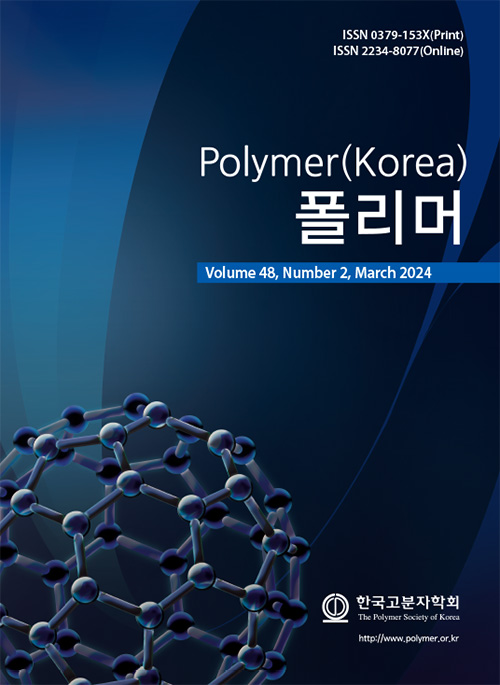- Filamentous Virus-Templated Nickel Hydroxide Nanoplates as Novel Electrochemical Pseudocapacitor Materials
Manoj Mayaji Ovhal
 , Hock Beng Lee
, Hock Beng Lee  , Neetesh Kumar
, Neetesh Kumar  , Jin-Woo Oh*
, Jin-Woo Oh*  , and Jae-Wook Kang†
, and Jae-Wook Kang† 
Department of Flexible and Printable Electronics, LANL-JBNU Engineering Instutute-Korea,
Jeonbuk National University, Jeonju 54896, Korea
*Department of Nano Fusion Technology, Department of Nanoenergy Engineering,
Research Center for Energy Convergence and Technology, Pusan National University, Busan 46241, Korea- 섬유상 바이러스를 이용한 니켈 수화물 나노플레이트 제조 및 전기화학 의사커패시터 특성
Manoj Mayaji Ovhal
 · Hock Beng Lee
· Hock Beng Lee  · Neetesh Kumar
· Neetesh Kumar  · 오진우*
· 오진우*  · 강재욱†
· 강재욱† 
전북대학교 유연인쇄전자공학과, *부산대학교 나노에너지공학과
Reproduction, stored in a retrieval system, or transmitted in any form of any part of this publication is permitted only by written permission from the Polymer Society of Korea.
Pseudocapacitive metal hydroxide nanostructures are promising active electrode materials for supercapacitor applications. Here, we demonstrate the in-situ growth of nickel hydroxide (Ni(OH)2) nanostructures on filamentous M13 bacteriophage template. The M13-Ni(OH)2 bio-nanostructure exhibits a fibrous morphology and a preferential growth orientation along the (001) crystal plane. Interestingly, the M13-Ni(OH)2 electrode demonstrates superior electrochemical properties. The areal capacitance (Ca) of M13-Ni(OH)2 and Ni(OH)2 electrodes was 18 mF/cm2 and 14 mF/cm2, respectively, indicating a 28% increase. The improved electrochemical performance is due to the increased surface roughness, enhanced charge adsorption/desorption sites, and reduced charge transfer resistance. This also contributed to an 18% increase in cyclic stability compared to the Ni(OH)2 electrode analogue. Overall, this work successfully shows the use of a bio-template to control the growth of novel metal-oxide nanostructures for energy storage applications.
본 연구는 M13 박테리오파지라는 생물학적 템플릿 위에 니켈 수산화물(Ni(OH)2) 나노구조체를 in-situ 성장시켜 섬유 모양의 뛰어난 전기화학적 특성을 가지는 M13-Ni(OH)2 전극을 개발하였다. 개발된 M13-Ni(OH)2 전극의 면적당 전기용량(Ca)은 14 mF/cm2로 기존의 Ni(OH)2 전극(Ca~18 mF/cm2) 보다 28% 증가된 우수한 특성을 보였다. 이러한 향상된 전기화학적 성능은 표면 거칠기 증가, 충전/방전 사이트 향상 및 전하 전달 저항 감소에 기인하였으며, 또한 기존 Ni(OH)2 전극 대비 18% 향상된 cycle 안정성을 보였다. 이 연구는 에너지 저장 분야에서 새로운 금속 산화물 나노구조체의 성장을 제어하기 위한 생체 템플릿의 사용 가능성을 보여주었다.
Keywords: M13 bacteriophage, active electrode, hydrothermal, energy storage, supercapacitor.
- Polymer(Korea) 폴리머
- Frequency : Bimonthly(odd)
ISSN 0379-153X(Print)
ISSN 2234-8077(Online)
Abbr. Polym. Korea - 2023 Impact Factor : 0.4
- Indexed in SCIE
 This Article
This Article
-
2024; 48(2): 234-241
Published online Nov 30, -0001
- 10.7317/pk.2024.48.2.234
- Received on Nov 30, -0001
- Revised on Nov 30, -0001
- Accepted on Nov 30, -0001
 Correspondence to
Correspondence to
- Jae-Wook Kang
-
Department of Flexible and Printable Electronics, LANL-JBNU Engineering Instutute-Korea,
Jeonbuk National University, Jeonju 54896, Korea - E-mail: jwkang@jbnu.ac.kr









 Copyright(c) The Polymer Society of Korea. All right reserved.
Copyright(c) The Polymer Society of Korea. All right reserved.